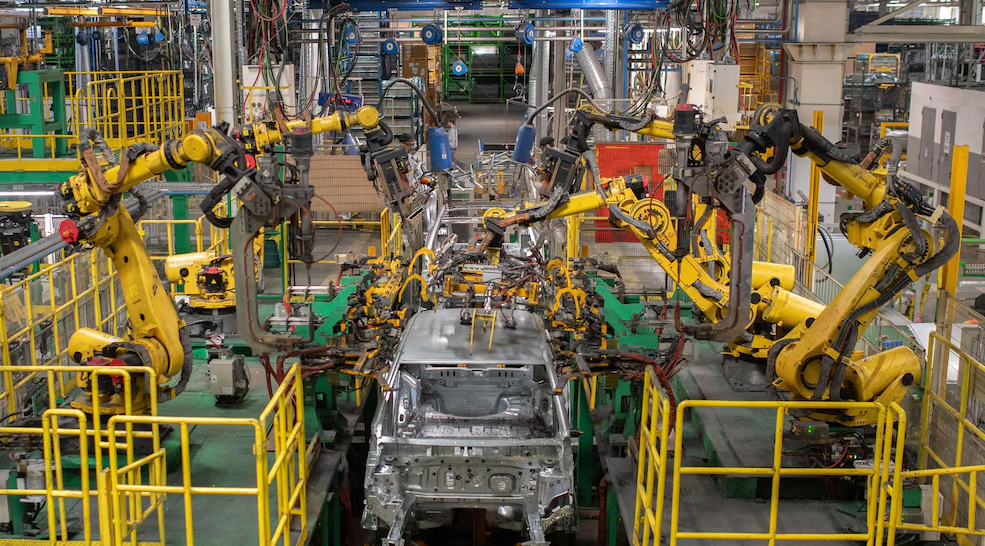Morocco’s Automotive Sector: Thousands of brand-new vehicles, freshly rolled off the assembly lines of French automaker Renault, sit in a vast parking lot on the outskirts of Tangier, Morocco, ready to make their way to Europe. This not only showcases Renault’s efficient operations but also underscores the booming automotive sector in Morocco. In fact, the sector has seen a [specific percentage] increase in output and a [specific percentage] increase in exports, setting new annual records.
With a sense of pride, Moroccan Minister of Trade and Industry Ryad Mezour lauds Morocco’s achievement, stating, “It’s the most competitive platform, to build automotives, the most decarbonized platform in the world.” In a mere fifteen years, Morocco has transformed from a negligible player to a projected annual capacity of one million vehicles by 2025, a remarkable feat that he underlines.
French carmaker Renault is at the head of the pack of over 250 enterprises involved in automobile manufacturing or component production, which is fueling this growth. Morocco, affectionately known as ‘Sandero-land,’ is home to Renault’s tiny Dacia Sanderos assembly plant. This nickname is a testament to the pervasive influence of car manufacturers in the region, as it reflects the significant presence of car manufacturing and the impact it has on the local economy.
The government of Morocco is not sitting on its hands; rather, it is playing a pivotal role in establishing Morocco as a leader in the emerging field of electric vehicles (EVs). Their systematic approach to development, including [specific policies or initiatives], has helped the car industry soar to new heights. This strong government support has been instrumental in the sector’s growth, with 22% of GDP and $14 billion in exports to show for it.
The fast decision-making and approval processes in Morocco, in contrast to many democracies, make the country an appealing option for businesses looking to move production to countries with lower production costs. According to Mezour, this is a major perk, since the permission procedure is lightning fast and the construction is usually finished in under five months.
Government officials have taken the initiative to improve the country’s infrastructure, pouring money into new ports, free trade zones, and improved highway systems. Producing a range of models, such as the hybrid Dacia Joggers and the widely-loved Dacia Sanderos in Europe, is made possible by generous subsidies of up to 35% offered to manufacturers in the rural areas near Tangiers.
As a showcase of Morocco’s varied industrial environment, Tangiers Automotive City is home to factories making vital auto parts for corporations in China, Japan, the US, and Korea. Stellantis adds to the ecosystem’s diversity by producing Peugeots, Opels, and Fiats at its Kenitra plant.
The Moroccan car industry is preparing for the transition as combustion engines are phased out in Europe. The strategic significance of Morocco is underscored by Mohamed Bachiri, Director of Renault Group’s Moroccan business, who estimates that yearly production capacity would reach 500,000 automobiles by 2025. This upward trajectory further solidifies Morocco as a leading exporter to over 70 nations, bolstering its position in the international car industry.
In line with a larger industrialization strategy to tap into the potential of a young labor population, Morocco is dedicated to fostering its automobile sector. This commitment is not just about providing low-cost labor to international investors. It’s about creating high-quality jobs that contribute to the country’s economic growth. Jobs in the automobile industry in Morocco generate above-average salaries, which helps to offset the effects of employment losses in other industries, such as agriculture. Despite wages being lower compared to Europe, the sector’s contribution to the economy is significant .
There are obstacles on the horizon even though Morocco is aggressively courting investment from the East and the West. One of the major challenges is the changing nature of electric vehicle production. As the world shifts towards electric vehicles, Morocco needs to adapt its manufacturing processes and supply chains. Additionally, the protectionist policies enacted by Western nations pose a threat. These policies could disrupt Morocco’s established supply networks and trade dynamics. However, the Moroccan government is actively working on potential solutions, such as [specific initiatives or strategies], to mitigate these challenges.
Ambassador Li Changlin of China to Morocco has recognized Morocco’s attractiveness as a partner in the automotive industry, praising the country’s advantageous economic climate and strategic location. Located at the crossroads of Europe, Africa, and the Middle East, Morocco offers easy access to multiple markets, making it an ideal hub for automotive manufacturing and export. As world powers compete for control of the electric vehicle market, Morocco’s strategic location could be a significant advantage, despite the formidable challenge of adapting to changing trade regulations and geopolitical realities.
The Moroccan government is vigilantly monitoring the evolving car industry and is advocating for more equitable trading practices. Propelled by innovation, strategic investments, and a skilled workforce ready for the future, Morocco’s automotive sector continues to thrive despite challenges posed by tariff policies and geopolitical developments.



















